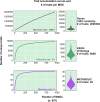Microbial functional diversity and redundancy: moving forward
- PMID: 39689915
- PMCID: PMC11756291
- DOI: 10.1093/femsre/fuae031
Microbial functional diversity and redundancy: moving forward
Abstract
Microbial functional ecology is expanding as we can now measure the traits of wild microbes that affect ecosystem functioning. Here, we review techniques and advances that could be the bedrock for a unified framework to study microbial functions. These include our newfound access to environmental microbial genomes, collections of microbial traits, but also our ability to study microbes' distribution and expression. We then explore the technical, ecological, and evolutionary processes that could explain environmental patterns of microbial functional diversity and redundancy. Next, we suggest reconciling microbiology with biodiversity-ecosystem functioning studies by experimentally testing the significance of microbial functional diversity and redundancy for the efficiency, resistance, and resilience of ecosystem processes. Such advances will aid in identifying state shifts and tipping points in microbiomes, enhancing our understanding of how and where will microbes guide Earth's biomes in the context of a changing planet.
Keywords: ecosystem functioning; functional redundancy; microbial functional ecology; resilience; resistance.
© The Author(s) 2024. Published by Oxford University Press on behalf of FEMS.
Conflict of interest statement
None declared.
Figures



References
-
- Aminot A, Kérouel R. Dosage Automatique Des Nutriments Dans Les Eaux Marines: Méthodes En Flux Continu. Ifremer, QUAE CN-2899, Versailles (France), 2007.
Publication types
MeSH terms
Grants and funding
LinkOut - more resources
Full Text Sources

